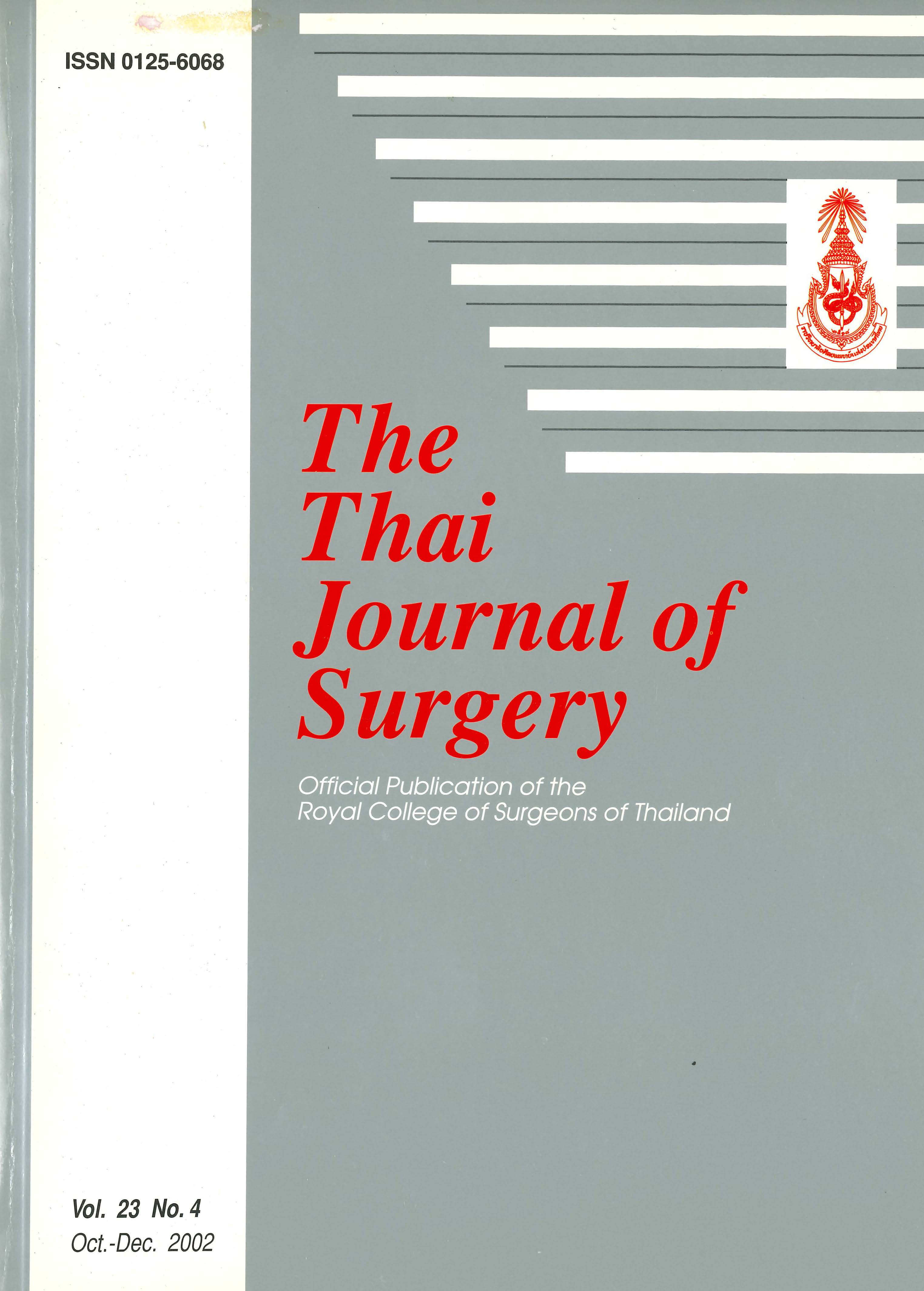Predicting Axillary Nodal Positivity in Patients with Breast Carcinoma Treated at Vajira Hospital
Abstract
Background: The single most significant predictive factor of survival in patients with breast cancer is the absolute number of lymph nodes involved with metastases. The purpose of this study was to estimate the likelihood of axillary lymph node involvement base on a variety of clinical and pathologic factors and determined the nodal positivity, survival and other prognostic factors.
Methods: All patients with breast cancer treated at Breast Clinic, Vajira Hospital from January 1994 through December 2001 who underwent modified radical mastectomy or axillary lymph node dissection as part of their treatment were evaluated.
Results: Of 204 breast cancer patients the axillary node metastases is 86 (42.2%). The axillary node metastases in nonpalpable tumor is 5 of 40 (12.5%) and palpable tumor is 81 of 164 (49.4%). The nonpalpable tumors have smaller size than palpable tumors, they are less likely to have positive axillary nodes (p 0.000) and less likely to have lymphatic vascular invasion (p 0.05). Nonpalpable tumors have a better survival than palpable tumor (p 0.0217).
Conclusions: For the breast cancer patients, the axillary lymph node metastases are positively correlated with tumor size, the axillary nodal status is the most significant predictive factor of survival. Nonpalpable tumors are more likely to be smaller and their nodal positivity is lower.
References
2. Henderson IC, Canellos GP. Cancer of the breast: The past decade. N Engl J Med 1980; 17: 302-6.
3. Fisher B, Wolmark N, et al. The accuracy of clinical nodal staging and of limited axillary dissection as a determinant of histologic nodal status in carcinoma of the breast. Surg Gynecol Obstet 1981; 152: 76-80.
4. Boova RS, Roseann B, et al. Patterns of axillary nodal involvement in breast cancer. Ann Surg 1982; 196: 64-8.
5. Henderson BE, Pike MC. Epidemiology and risk factors. In: Diagnosis and Management. Breast Cancer. John Wiley & Sons, 1984:15-33.
6. Koscielny S, Tubiana M, et al. Breast cancer: Relationship between the size of the primary tumor and the probability of metastatic dissemination. Br J Cancer 1984; 709: 49-52.
7. Ciatto S, Cataliotti L, et al. Nonpalpable lesions detected with mammography. Review Of 512 consecutive cases. Radiology 1987; 99: 165-8.
8. Hall FM, Storella JM, et al. Nonpalpable breast lesions: Recommendation for biopsy based on suspicious of carcinoma at mammography. Radiology 1988; 167:353-6.
9. Rosen PP, Groshen S, Saigo PE, Kinne DW, Hellman S. Pathological prognostic factors in stage I and stage ll breast carcinoma: a study of 644 patients with a median follow-up of 18 years. J Clin Oncol 1989; 73: 123-9.
10. Carter CL, Allen C, Henson D. Relation of tumor size, lymph node status, and survival in 24, 740 breast cancer cases. Cancer 1989;63:181-8.
11. Harris JR, Lippman ME, et al. Breast cancer. N Engl J Med 1992; 325: 319-22.
12. Garfinkel L, Boring CC, et al. Changing trends: An overview of cancer incidence and mortality. Cancer 1994;74:222-7.
13. Eberlein TJ. Current management of carcinoma of the breast. Ann Surg 1994; 121: 220-5.
14. Giuliano AE, Kirgan DM, et al. Lymphatic mapping and sentinel lymphadenectomy of breast cancer. Ann Surg 1994;22: 391-6.
15. Giuliano AE, Dale PS, et al. Improved axillary staging of breast cancer with sentinel lymphadenectomy. Ann Surg 1994;220: 391-6.
16. Solin LJ, Legerreta A, et al. The importance of mammographic screening relative to the treatment of women with carcinoma of the breast. Arch Internal Med 1994; 745: 154-60.
17. Jacobson JA, Danforth DN, et al. Ten-year results of a comparison of conservation with mastectomy in the treatment of stage I and l breast cancer. N Engl J Med 1995;332:90-7.
18. Yim J H, Premsri B, et al. Mammographically detected breast cancer : Benefits of stereotactic core versus wire localization biopsy. Ann Surg 1996; 223: 68-70.
Downloads
Published
How to Cite
Issue
Section
License
Articles must be contributed solely to The Thai Journal of Surgery and when published become the property of the Royal College of Surgeons of Thailand. The Royal College of Surgeons of Thailand reserves copyright on all published materials and such materials may not be reproduced in any form without the written permission.



